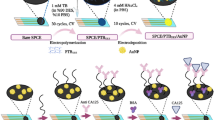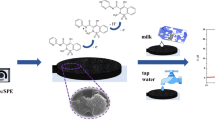Abstract
A simple label-free electrochemical immunosensor for ovarian cancer (OC) detection was developed using a hierarchical microporous carbon material fabricated from waste coffee grounds (WCG). The analysis method exploited near-field communication (NFC) and a smartphone-based potentiostat. Waste coffee grounds were pyrolyzed with potassium hydroxide and used to modify a screen-printed electrode. The modified screen-printed electrode was decorated with gold nanoparticles (AuNPs) to capture a specific antibody. The modification and immobilization processes were characterized by cyclic voltammetry (CV) and electrochemical impedance spectroscopy (EIS). The sensor had an effective dynamic range of 0.5 to 50.0 U mL-1 of cancer antigen 125 (CA125) tumor marker with a correlation coefficient of 0.9995. The limit of detection (LOD) was 0.4 U mL-1. A comparison of the results obtained from human serum analysis with the proposed immunosensor and the results obtained from the clinical method confirmed the accuracy and precision of the proposed immunosensor.
Graphical abstract






Similar content being viewed by others
References
Shabir S, Gill PK (2020) Global scenario on ovarian cancer – Its dynamics, relative survival, treatment, and epidemiology. Adesh Univ J Med Sci Res 2:17–25
Charkhchi P, Cybulski C, Gronwald J, Wong FO, Narod SA, Akbari MR (2020) CA125 and ovarian cancer: a comprehensive review. Cancers 12:3730
Shen F, Chen S, Gao Y, Dai X, Chen Q (2017) The prevalence of malignant and borderline ovarian cancer in pre- and post-menopausal Chinese women. Oncotarget 8:80589–80594
Doubeni CA, Doubeni AR, Myers AE (2016) Diagnosis and management of ovarian cancer. Am Fam Physician 93:937–944
Bayoumy S, Hyytiä H, Leivo J, Talha SM, Huhtinen K, Poutanen M, Hynninen J, Perheentupa A, Lamminmäki U, Gidwani K, Pettersson K (2020) Glycovariant-based lateral flow immunoassay to detect ovarian cancer–associated serum CA125. Commun Biol 3:460
Li Y, Wang ZC, Luo L, Mu CY, Xu J, Feng Q, Li SB, Gu B, Ma P, Lan T (2020) The clinical value of the combined detection of sEGFR, CA125 and HE4 for epithelial ovarian cancer diagnosis. Eur Rev Med Pharmacol Sci 24:604–610
Kumar N, Sharma S, Nara S (2018) Dual gold nanostructure-based electrochemical immunosensor for CA125 detection, Applied. Nanoscience 8:1843–1853
Sadighbayan D, Sadighbayan K, Tohid-kia MR, Khosroushahi AY, Hasanzadeh M (2019) Development of electrochemical biosensors for tumor marker determination towards cancer diagnosis: Recent progress. TrAC Trends Anal Chem 118:73–88
Madhvapathy SR, Wang H, Kong J, Zhang M, Lee JY, Park JB, Jang H, Xie Z, Cao J, Avila R, Wei C, D'Angelo V, Zhu J, Chung HU, Coughlin S, Patel M, Winograd J, Lim J, Banks A et al (2020) Reliable, low-cost, fully integrated hydration sensors for monitoring and diagnosis of inflammatory skin diseases in any environment. Sci Adv 6:1–12
Xu G, Cheng C, Yuan W, Liu Z, Zhu L, Li X, Lu Y, Chen Z, Liu J, Cui Z, Liu J, Men H, Liu Q (2019) Smartphone-based battery-free and flexible electrochemical patch for calcium and chloride ions detections in biofluids. Sens Actuators B 297:126743
Teengam P, Siangproh W, Tontisirin S, Jiraseree-amornkun A, Chuaypen N, Tangkijvanich P, Henry CS, Ngamrojanavanich N, Chailapakul O (2021) NFC-enabling smartphone-based portable amperometric immunosensor for hepatitis B virus detection. Sens Actuators B 326:128825
Merazzo KJ, Totoricaguena-Gorriño J, Fernández-Martín E, Del Campo FJ, Baldrich E (2021) Smartphone-enabled personalized diagnostics: current status and future prospects. Diagnostics (Basel, Switzerland) 11:1067
Roda A, Michelini E, Zangheri M, Fusco M, Calabria D, Simoni P (2015) Smartphone-based biosensors: a critical review and perspectives. TrAC Trends Anal Chem 79:317–325
Samoggia A, Riedel B (2019) Consumers' perceptions of coffee health benefits and motives for coffee consumption and purchasing. Nutrients 11:653
Figueroa Campos GA, Perez JPH, Block I, Sagu ST, Saravia Celis P, Taubert A, Rawel HM (2021) Preparation of activated carbons from spent coffee grounds and coffee parchment and assessment of their adsorbent efficiency. Processes 9:1396
Mariana M, Mulana F, Yunardi Y, Ismail T, Hafdiansyah M (2018) Activation and characterization of waste coffee grounds as bio-sorbent. IOP Conf SerMater Sci Eng 334:012029
Pagalan E Jr, Sebron M, Gomez S, Salva SJ, Ampusta R, Macarayo AJ, Joyno C, Ido A, Arazo R (2020) Activated carbon from spent coffee grounds as an adsorbent for treatment of water contaminated by aniline yellow dye. Ind Crop Prod 145:111953
Biegun M, Dymerska A, Chen X, Mijowska E (2020) Study of the active carbon from used coffee grounds as the active material for a high-temperature stable supercapacitor with ionic-liquid electrolyte. Materials (Basel, Switzerland) 13:3919
Chung DY, Son YJ, Yoo JM, Kang JS, Ahn C-Y, Park S, Sung Y-E (2017) Coffee waste-derived hierarchical porous carbon as a highly active and durable electrocatalyst for electrochemical energy applications. ACS Appl Mater Interfaces 9:41303–41313
Park M, Yun YS, Cho S, Kim NR, Jin HJ (2016) Waste coffee grounds-derived nanoporous carbon nanosheets for supercapacitors. Carbon Lett 19:66–71
Malekzad H, Zangabad PS, Mirshekari H, Karimi M, Hamblin MR (2017) Noble metal nanoparticles in biosensors: recent studies and applications. Nanotechnol Rev 6:301–329
Khashayar P, Amoabediny G, Larijani B, Hosseini M, Verplancke R, Schaubroeck D, Keersmaecker MD, Adriaens M, Vanfleteren J (2016) Characterization of gold nanoparticle layer deposited on gold electrode by various techniques for improved sensing abilities, Biointerface Research in Applied. Chemistry 6:1380–1390
Pingarrón J, Yáñez-Sedeño P, González-Cortés A (2008) Gold nanoparticle-based electrochemical biosensors. Electrochim Acta 53:5848–5866
Wang C-H, Wen W-C, Hsu H-C, Yao B-Y (2016) High-capacitance KOH-activated nitrogen-containing porous carbon material from waste coffee grounds in supercapacitor. Adv Powder Technol 27:1387–1395
Jagdale P, Ziegler D, Rovere M, Tulliani JM (2019) Tagliaferro, Alberto, Waste coffee ground biochar: a material for humidity sensors. Sensors (Basel, Switzerland) 19:801
Jazayeri MH, Amani H, Pourfatollah AA, Pazoki-Toroudi H, Sedighimoghaddam B (2016) Various methods of gold nanoparticles (GNPs) conjugation to antibodies. Sens Bio-Sens Res 9:17–22
Zhang J, Xue J, Li P, Huang S, Feng H, Luo H (2018) Preparation of metal-organic framework-derived porous carbon and study of its supercapacitive performance. Electrochim Acta 284:328–335
Wang J, Kaskel S (2012) KOH activation of carbon-based materials for energy storage. J Mater Chem 22:23710–23725
Lozano-Castelló D, Calo JM, Cazorla-Amorós D, Linares-Solano A (2007) Carbon activation with KOH as explored by temperature programmed techniques, and the effects of hydrogen. Carbon 45:2529–2536
Otowa T, Tanibata R, Itoh M (1993) Production and adsorption characteristics of MAXSORB: high-surface-area active carbon. Gas Sep Purif 7:241–245
Qiao W, Yoon S-H, Mochida I (2006) KOH activation of needle coke to develop activated carbons for high-performance EDLC. Energy Fuel 20:1680–1684
Raymundo-Piñero E, Azaïs P, Cacciaguerra T, Cazorla-Amorós D, Linares-Solano A, Béguin F (2005) KOH and NaOH activation mechanisms of multiwalled carbon nanotubes with different structural organisation. Carbon 43:786–795
Wang H, Gao Q, Hu J (2009) High hydrogen storage capacity of porous carbons prepared by using activated carbon. J Am Chem Soc 131:7016–7022
El-Azazy M, El-Shafie AS, Morsy H (2021) Biochar of spent coffee grounds as per se and impregnated with TiO2: promising waste-derived adsorbents for balofloxacin. Molecules 26:2295
Barrios Rodriguez Y, Collazos Escobar G, Guzmán N (2021) ATR-FTIR for characterizing and differentiating dried and ground coffee cherry pulp of different varieties (Coffea Arabica L.). Eng Agric 41:70–77
Chou W-L, Wang C-T, Huang K-Y, Chang Y-C, Shu CM (2012) Investigation of indium ions removal from aqueous solutions using spent coffee grounds. Int J Phys Sci 7:2445–2454
Gao Z, Li Y, Zhang C, Zhang S, Li F, Wang P, Wang H, Wei Q (2019) Label-free electrochemical immunosensor for insulin detection by high-efficiency synergy strategy of Pd NPs@3D MoSx towards H2O2. Biosens Bioelectron 126:108–114
Swartz ME (1997) Analytical method development and validation. CRC Press
AOAC (2016) Guidelines for standard method performance requirements. AOAC International, Rockville, Maryland
Örnemark BMAU (2014) The Fitness for purpose of analytical methods – a laboratory guide to method validation and related topics. Eurachem Guide, Gembloux, Belgique
Acknowledgments
The authors are grateful for financial support from the National Research Council of Thailand (NRCT), Ministry of Higher Education, Science, Research and Innovation, the National Science, Research and Innovation Fund (NSRF) and Prince of Songkla University (Grant No SCI6601337S), the center of Excellence for Trace Analysis and Biosensor (TAB-CoE), the Talent Management Project, the Forensic Science Innovation and Service Center, the Center of Excellence for Innovation in Chemistry (PERCH-CIC), the Division of Health and Applied Sciences, the Division of Physical Science, the Faculty of Science, Prince of Songkla University, Hat Yai, Thailand, and Silicon Craft Technology PLC. Thanks also go to Mr. Thomas Duncan Coyne, Faculty of Science, Prince of Songkla University, Hatyai, Thailand for assistance with the English text.
Author information
Authors and Affiliations
Corresponding author
Ethics declarations
Conflict of interest
The authors declare no competing interests.
Additional information
Publisher’s note
Springer Nature remains neutral with regard to jurisdictional claims in published maps and institutional affiliations.
Supplementary information
ESM 1
(DOCX 782 kb)
Rights and permissions
Springer Nature or its licensor (e.g. a society or other partner) holds exclusive rights to this article under a publishing agreement with the author(s) or other rightsholder(s); author self-archiving of the accepted manuscript version of this article is solely governed by the terms of such publishing agreement and applicable law.
About this article
Cite this article
Cotchim, S., Thavarungkul, P., Kanatharana, P. et al. A portable electrochemical immunosensor for ovarian cancer uses hierarchical microporous carbon material from waste coffee grounds. Microchim Acta 190, 232 (2023). https://doi.org/10.1007/s00604-023-05798-9
Received:
Accepted:
Published:
DOI: https://doi.org/10.1007/s00604-023-05798-9




